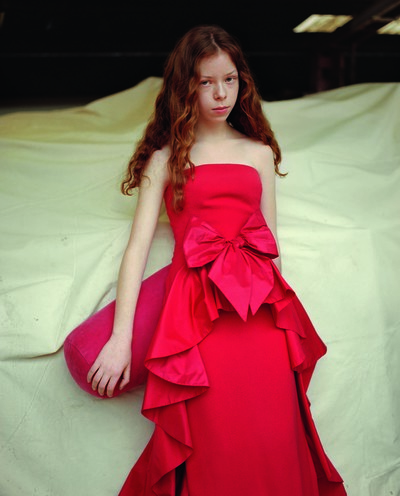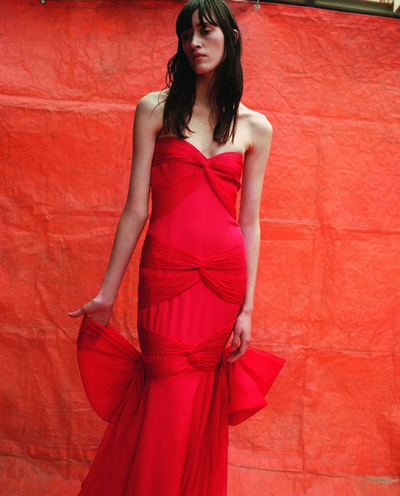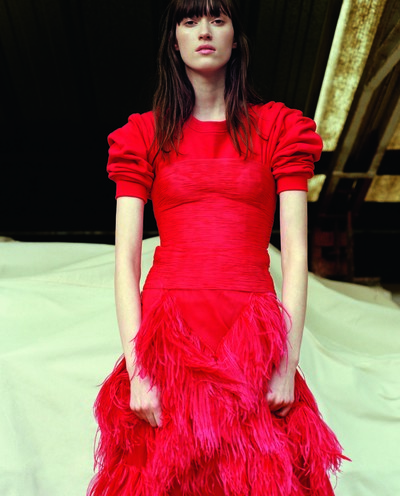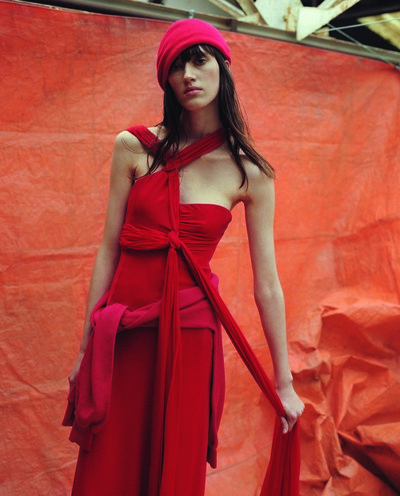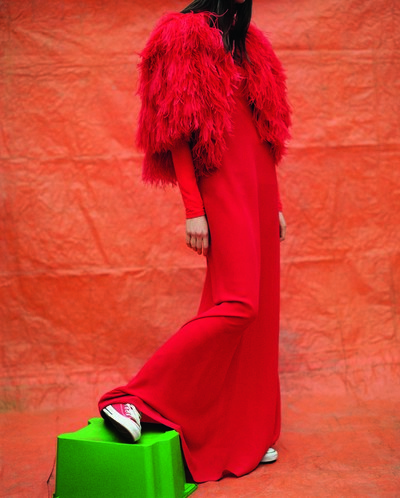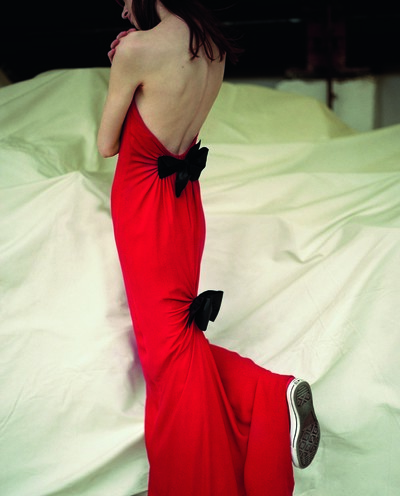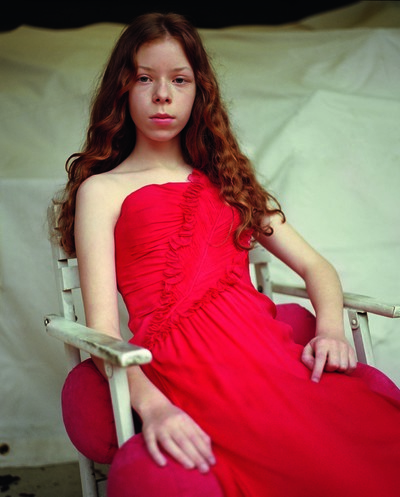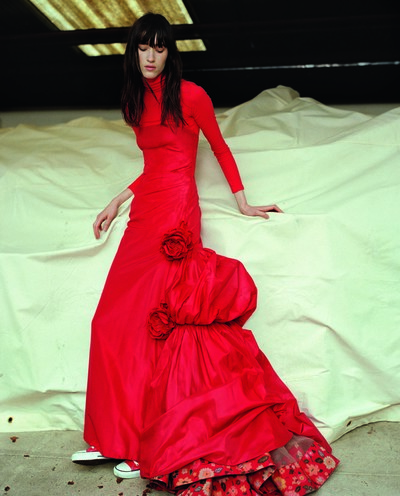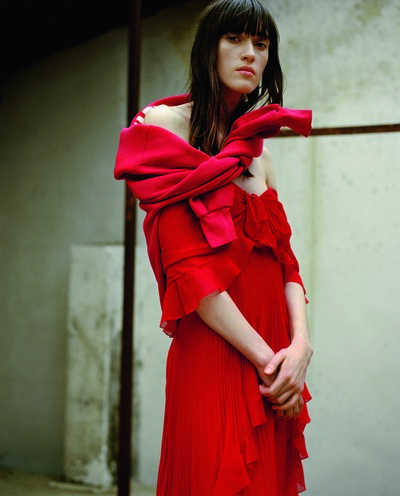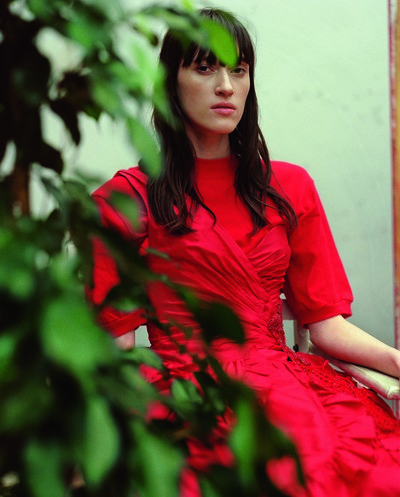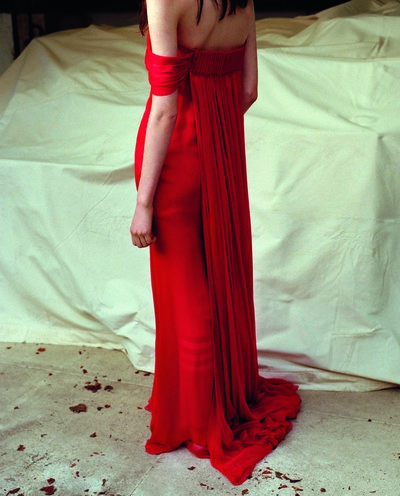Mr Valentino on 45 years of seeing red.
By Hans Ulrich Obrist
Photographs by Zoë Ghertner
Styling by Camille Bidault-Waddington
Mr Valentino on 45 years of seeing red.
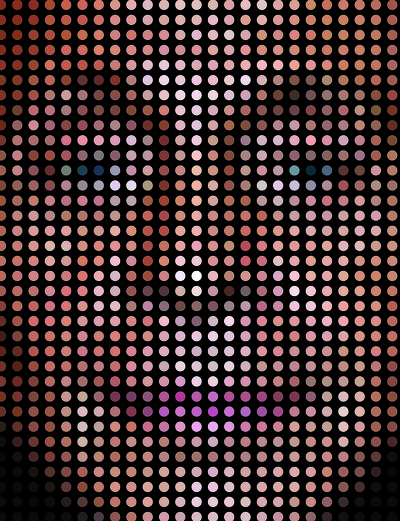
A figurehead of fashion aristocracy, it’s easy to forget that behind the immaculately groomed, bespoke-suited veneer, Valentino Garavani was once a young couturier struggling to find his way on his return to Rome in 1960 after a stint as an apprentice to Jean Dessès and Guy Laroche in Paris. The year Fellini filmed La Dolce Vita was a fateful one for Valentino – as not only did Rome become a destination for the international glitterati, delivering the great and the good to the doors of his atelier – it was the year he met the architecture student Giancarlo Giammetti. It was a meeting of minds, and spirits, that would form one of the most significant professional and personal partnerships in fashion: one that would last for a lifetime.
Recognising fashion’s future was in ready-to-wear, Giammetti structured a series of manufacturing deals that laid the foundations of the brand’s international expansion, while Garavani focused on creating beautiful clothes whose simplicity belies the perfection of their cut. Timeless elegance, impeccable taste, cinematic glamour – such was Garavani’s talent, that trying to define Valentino in these terms today is an exercise in tautology for the house, and its relationships with some of the most iconic personalities of the past sixty years have done as much, if not more, to define these visions of beauty as any medium or imagination.
Today, seven years after he ‘retired’ at the age of 75, Garavani can look back on his 45-year career, and marvel at its many firsts for fashion; the first brand to license its name to perfume and leather companies, the first brand to publicly collaborate with an artist in a marketing campaign (the artist being Andy Warhol, no less), the first fashion designer to be given a retrospective at New York’s Metropolitan Museum of Art. And to look forward, at his legacy continued today by Valentino’s creative directors Maria Grazia Chiuri and Pier Paolo Piccioli. Or, he could just sit back, relax and gaze upon the vast art collection he has amassed in homes around the world; like the one in London’s Holland Park with its late Picassos and works by Jean-Michel Basquiat and Damien Hirst, where he is joined by the Swiss curator Hans Ulrich Obrist to discuss the search for perfection, the colour red, and how he really feels about being called the “last emperor” of Roman glamour.
Hans Ulrich Obrist: So let’s start at the beginning, how it all started and if you had an epiphany which brought you to fashion because as far as I understand it was cinema…
Valentino Garavani: Yes cinema, I’ve always had this passion for beautiful dresses from when I was a little child. My cousins used to dress very, very well, and every time they wore an evening gown, I was there staring at them. I was six or seven years old, not more, and then I automatically grew interested in the movies. I was not supposed to see them, but I had an older sister whose boyfriend would take her to the cinema, so she used the excuse of bringing me along as somebody who could keep an eye on her. So film, silver screen, beautiful films with beautiful stars wearing beautiful dresses; for me at that time, they were like a dream. Automatically, without any reason, I just had a passion for designing. I was very good at design at school, and so I started to make some fashion drawings, without any particular style. I did some marionettes, but my big relaxation was just to draw dresses. I didn’t have anything else on my mind, just dresses, beauty, films, and very well dressed beautiful ladies. I naturally went in that direction: I told my parents that I didn’t want to go on studying Latin and Greek and would love to be a fashion designer.
You have also mentioned that colour was an early inspiration.
Valentino: That started later. Red was the first colour to have a big impact on me. I had seen several things in red and I was fascinated with this colour. Later on I put it in my collection, and I realised then that red is one of the most becoming colours…
Because red is the strongest colour. As Etel Adnan says, in a painting, red is always the colour that stands out…
Valentino: Red was the first colour to stand out. Then with age and a different approach, I started to love art very much. My first things were the [Lucio] Fontana and the [Arnaldo] Pomodoro sculpture. And the first big thing I bought was a Picasso with beautiful colours. Automatically when you see a beautiful painting, a Picasso or a Basquiat, you try and put it into your collection – especially Basquiat because I did a collection a not very long time ago in the 1990s where I showed several Basquiat details in the dresses.
‘I am crazy about beauty. To be in a room where you look around and you see so many beautiful people and things, gives you force and strength.’
Did you know Basquiat personally?
Valentino: I met him because he came to my shows: he was in love with a girl who was doing my collection, and he came with her. He was sitting in a corridor of the fashion house and he fell asleep – but you know the most amazing thing is that we all left him there, and he stayed all night; they locked him in the fashion house. He was a charming, charming guy and very sadly, he died very young.
Did you collect his paintings in the 1980s?
Valentino: No, no, his paintings I collected 15 years ago, ten years ago.
They are amazing. There are so many connections between fashion and art; Yves Saint Laurent with the Mondrian dresses, Chanel – not very much has been written about your connection with the arts, and I thought it would be interesting to talk a little more… So you took details of the paintings and put them in the clothes?
Valentino: Yes, I did that with little short dresses for cocktail time, and I did some shirts with the print.
What is it that attracts you to Basquiat?
Valentino: His use of colour is the strongest out of all those figures. He has always fascinated me. I am very happy because with time he has become one of the most important artists of the 20th century.
As well as Picasso and Basquiat… Are there other artists?
Valentino: I love [Willem] de Kooning; I love Peter Doig very, very much. I love [Gerhard] Richter very much – I have a very beautiful painting of his. And of course, I love Andy [Warhol] because I met him and we used to see each other a lot. He also did my portrait.
How was it with Andy and you? Can you tell me about this?
Valentino: He was very nice all the time with me, he invited me to the Factory many times, and I was admiring all the paintings on the floor – you had to be careful not to step on them. He was a charming person with lots of intriguing ways to talk. He was very, very nice.
How did he do your portrait?
Valentino: He asked me in 1970-something. He took a Polaroid: he was constantly taking Polaroids, and he said ‘I am making a portrait’, and he did four of them. But you know strangely enough, when one of his assistants said the portraits were ready, I was not crazy about them. And I said let me think about it, and I didn’t buy it right away. I bought it several years after – two were available and two were in the museum in Chicago, I think. So I have two, which are here by the way.
And what about the connection to society? Because I am interested in how art and fashion can go beyond the realm of aesthetics because it goes into society… How do you see that?
Valentino: Oh my gosh, I have met so many people and been involved with many, many occasions. When I was a young boy in fashion I had already been to many beautiful homes and saw beautiful paintings. This was a dream. But you know, I am not upset that I started [collecting] maybe a little late. Before I always talked about a piece of furniture, china, or lots of beautiful objects because I am crazy for beauty like this – but when I started to think about art, I started very strongly.
You capture beauty and the essence of beauty when you make clothes; but how can one define beauty?
Valentino: It is very difficult for me to explain this, because I honestly think it is just something that I learnt automatically. I woke up one day and my eyes just went to the corner or the panel or the house or the street and could see something that was beautiful. It is very difficult to explain in words. Also these days, I just want to fill my eyes with beauty. I want to see beautiful flowers, beautiful objects, beautiful human beings – beautiful everything.
That now leads us to the Valentino woman…
Valentino: I always used very, very good models. I was very choosy when the girls would come to the fashion house, but I was just attracted by beauty and I was designing for that. For instance, one of the last ones is a big star, and that is Gisele [Bündchen]. When I saw her for the first time, I thought she was one of the most beautiful women in the world. When you are around beauty, you are fascinated by it and you enjoy to see it and participate in it. To be in a room where you look around and you see so many beautiful things is not only enjoyable – it also gives people lots of force, lots of strength, from looking at them.
‘Automatically when you see a beautiful painting with beautiful colours — a Picasso or a Basquiat — you try and put it in your collection.’
Do you think this idea of aesthetic perfection is achievable? Is there such a thing as perfect beauty?
Valentino: In fashion? Firstly, I think I am speaking for myself and for other designers; you have to believe in what you do and what you draw. You have to understand what it is when you do a drawing and you look at a drawing and you say, this is a dress that is going to be on the runway for my future collection. I have always been quite lucky because I always looked at my drawings and said this is going to be extraordinary in my shows, and automatically I was very careful to choose the most beautiful materials, because you know they go together. For a beautiful drawing you need a beautiful material, you need the beautiful woman who is wearing this and the beautiful décor for when you show this on the runway – the runway has to be beautiful; the atmosphere, the music – there are so many things involved all around you.
Do you still draw?
Valentino: Oh yes all the time. All the time. It is one of the things I like the most with design.
Because with the computer we are losing handwriting.
Valentino: Yes, but with a computer I don’t know if you can do a beautiful, subtle, full of charm, drawing. I don’t know. I am not capable to do anything. I love to have a telephone with the holes because I am not capable of using anything.
Do you still draw every day?
Valentino: Every day, because I absolutely love to draw. With a good pen I can do it very, very fast, in five seconds.
Have your drawings ever been published?
Valentino: No, I do it for myself. When I stopped designing, I did a big gala for the New York City Ballet where I made costumes for the ballet, and I had this huge evening where they gave a standing ovation for the clothes that I made. So I draw automatically ballet things. It was the second time, just after I stopping working, that I did the Vienna ballet. I did lots of exhibitions, everywhere, and also the documentary they made about me – do you know about this?
What did you think about it, because it was called The Last Emperor…
Valentino: I have to tell you, that when they started to film all my life and all of my story and everything, it was non-stop, and stupidly I didn’t pay attention because I was working and doing fittings and being taken from my job constantly – and of course I remembered I always had somebody behind my shoulders, but I didn’t give lots of importance to it, you understand? Finally, they did lots of work and in the end when I saw the film in New York, I was not crazy about it.
And the title, who chose that? Was it you?
Valentino: No, they chose that. I was not so crazy about it, but after the first evening when we presented the documentary for the gala of the second night in Venice to a huge, huge crowd, they gave a standing ovation at the end of the film.
There is something very interesting about it; it is very Andy Warhol, this idea that everything gets documented. It is non-stop, 24 hours…
Valentino: I have to admit that after Venice, after Toronto and then the Metropolitan – I did lots of tours – I started to like the documentary.
In the film there is a very big role played by Giancarlo Giammetti. It would be interesting to hear about your relationship with Giancarlo…
Valentino: Giancarlo was close to me, he would organise the collection, organise the layout of pictures in magazines, the fashion shows. He did a lot and gave me the possibility to work very calmly and without shocks. I was locked in my studio, drawing, and doing fittings. I try to love my clothes as much as possible.
So you were free.
Valentino: Exactly.
I am very interested in the magical moments of cities, and there was clearly a magical moment in Rome in the 1950s because there was Fellini…
Valentino: This was around the time of the opening of my fashion house, my debut – I was drugged by this sort of life. I was extremely young. You have to understand that at that moment, to be 26 and to have on your shoulders a huge fashion house with lots of workers and this and that: it was a big thing. But I was very happy and I went on and on, and in 1968 I had a huge success and my name went around the world.
So it was in ‘68 that it all exploded?
Valentino: Yes with the White Collection.
‘I don’t think you can create beautiful, subtle, full of charm drawings on a computer. But what do I know? I still love to have a telephone with holes in.’
Before we talk about the White Collection, I wanted to ask you a bit more about Rome in the 1950s and early ‘60s. This is an incredible moment, such an amazing one that even artists like Cy Twombly and [Robert] Rauschenberg came to Rome – what was it about the city then?
Valentino: We were involved because we were very close with a lady who was the directrice of the Marlborough Gallery. We sold the first Fontana, the first sculpture of Pomodoro; we sold lots of little things and we were attracted by this. But money was not such a big drive, though I did buy some Fontana[s], some sculptures that I have today and that I am very happy to have because they touch the roof. They are so amazing for what they cost today, you wouldn’t believe it.
Why do you think that Rome was so amazing then, so magnetic?
Valentino: Well Rome is a beautiful city. There is also something magical with this city – all the people used to go there to watch everything, the museums – you have to understand that in Italy we have the best museums in the world, though they are not very brilliantly kept…
But you were very prepared to start because you had amazing teachers and mentors; Balenciaga, Jacques Fath, Guy Laroche…
Valentino: Yes, but this was when I was 17.
Can you tell me what you learnt from them?
Valentino: I was 15 when I arrived in Paris. When I was 18 I went to the academy for the Chambre Syndicale de la Couture, the school where I learnt to draw, and where I was in touch with all the other guys and girls doing the same job – and automatically this was a big fascination because I loved it so deeply. After one year I had the chance to go to Jean Dessès, and he was – with Fath and Balmain and Dior – one of the biggest designers at that time. He was Greek originally. I stayed working with him for five years.
What did you learn from him?
Valentino: What I learned from him was to perfect my drawings. I learned from looking at the collections. Later on, after four years, he asked me to go to the studio privately when he was making the collections, so I breathed in the atmosphere of what to do when you do a collection. After a little while I moved to Guy Laroche, from him I learned a lot and after two years I learnt maybe everything – and thought, why not go back to Rome and open my own fashion house?
In the early 1960s in Rome you became very famous for your red dresses, and I am interested in this because in art we talk about Klein Blue5, and with you we talk about a Valentino red…
Valentino: I do not want to say much about this because it is too much about me – but yes I came out with this Valentino red, and I loved it so much because I told a lady when she dressed in red that if she arrived at a party, all the people are already there will see something amazing in her. If you do the right red it touches everybody.
So it is bright shade?
Valentino: Yes, a very bright red, a little orangey.
Can you tell me about your debut at the Pitti Palace in 1962?
Valentino: I was there but I was not so well known at the time – they put me on the last day and at the last hour so I was quite, not sad, but quite upset. I had the hugest chance with this collection but I thought no one would stay because it was so late, but it was the opposite; all the buyers stayed and said, ‘This is a new person, let’s see what he does’. And I had huge success. They bought even though it was after 11.30 at night; they bought numerous things. The following year, they gave me the right time on the right day in the right room. But I have to tell you, I was very lucky. Thank god, I have to thank life and the people in my life, everyone and everything, because I was extremely lucky and I have to tell you something; I didn’t meet deception.
So you have no regrets, there are no unrealised projects?
Valentino: No, no, no, everything went well and I was extremely happy. I was somebody who was designing lots of collections – at one point I was doing ten collections per year and that was very important. But you know, I was quite easy going, and I remember on a Friday, I was like, ‘Let’s take a day off’. And then on the Monday I had to start work on my show, but that was no problem: I would sit down at my table and start to draw, and I put together my collection without any anguish. It was very easy and I was extremely happy.
‘After Mrs Kennedy bought that dress, we sold the same model 30 times! Selling one couture dress 30 times is like selling 30 Basquiats in one second.’
In a way your moment of international fame arrived in 1968 with the White Collection – it went completely global. Do you remember the day you came up with the White Collection? Was there an epiphany?
Valentino: The White Collection is something that came to me, and I said I had to showcase something white – I took my ideas and I said I am going to do almost the whole end of the show in just white. And nobody was expecting to see a white collection. It was a big, big success and it was the best moment of my life.
As the artist Absalon often told me; white has very different meaning in the West than in the East. What did it mean to you? And how does red fit into that?
Valentino: In 1968 when I did the White Collection, I didn’t have any red dresses. I started them immediately afterwards… no I am wrong, red is earlier. One of the dresses that did a tour of the world and could be worn right now, I did it in 1961.
At your great 45th anniversary show you presented your most legendary dresses, and I was wondering if you could possibly talk about one or two of your favourites?
Valentino: Oh my gosh, there are so many, it is very difficult… I was one of the first to start using animal print; the zebra, the leopard, the giraffe – and I have all the dresses of that moment and they are in exhibitions around the world all of the time. They are very popular now, too.
Maybe we could talk about the dresses you did for Mrs Kennedy?
Valentino: They were from the White Collection. I had this almost white, creamy dress in which I was automatically thinking of Mrs Kennedy, and she bought that dress one summer in the month of September, or October. They announced what she was wearing in the press when she married [Aristotle] Onassis, and all the newspapers called to ask whether it was me who made the dress, and I said I had no idea. And then they said, ‘Ah, but we know she was in New York and she ordered a creamy coloured dress, it must be you!’ They knew before me that she was wearing that fabulous dress. And I have to say that after Mrs Kennedy bought this dress, we sold the same model in the collection 30 times! In high fashion, selling one dress 30 times is like an exhibition selling 30 Basquiats in one second.
And what about Audrey Hepburn, because in interviews you often mention her?
Valentino: Audrey became a great friend of mine, because at a certain point she left behind all the life that she had in America when she married an Italian doctor. And she used to really draw. She was the biggest customer of Givenchy, but then she became one of the biggest customers of Valentino. We became very good friends, she was so sweet; one of the sweetest I ever met. Oh my god, I remember off by heart what I did for her – she wore so many amazing pieces, amazing pyjamas and a beautiful organza dress all in white. I remember everything I did for her. I have so many memories of her, ahhh…
Did you ever write an autobiography?
Valentino: No, but many have been written about me. Also, one very close friend, who marked me a lot in my life, was Elizabeth Taylor. She used to come to the chalet in Gstaad because she was up and I was down, and she would come down. She would come for New Year’s Eve for dinner.
Do you remember any special dresses you made for Elizabeth Taylor?
Valentino: Oh my god, so many. From the White Collection I made a dress with ostrich feathers which she wore for a huge, huge party for the film Spartacus. And she had this dress with a white satin coat on top. And at a certain point — this was really at the very beginning — I said Elizabeth, no Mrs Taylor, may I have a picture taken with you? And she said, ‘Oh yes, of course’. And I went close to her and they took the picture, and she said, ‘You must give me one dress for free’. And I said, ‘Yes of course, of course’. Two days later, she arrived there in the middle of the fashion show before we had started – all the ladies were in two big rooms, and they were all so happy to see Elizabeth Taylor – and she came and said, ‘I have come to choose my dress.’
Amazing.
Valentino: I had the new collection, and I showed her a few things and she chose the most expensive one!
Which was one it?
Valentino: It was a coat in brown velvet with zebra around, and a dress in pale, pale green with some embroidery. It was very expensive! So I made it for her and we became very close friends. These were my early days. I didn’t then see her for several years, until finally one day she appeared – and of course by then I had become Valentino – and one day I got the message from my secretary saying Mrs Taylor had called from the Grand Hotel, and she asked if you can have lunch with her in two days at 12. So I was like, ‘Oh my gosh, after so many years, suddenly she’s calling me again’ – and as she was kissing me like I had only seen her three days before. So we became Elizabeth and Valentino, and she told me she was invited by the Rothschild family to a big ball in Paris, and I made the famous black dress that was photographed by [Richard] Avedon. Finally, a few years ago, there was the big sale of all her dresses and her jewellery, and that dress was sold for a very big sum of money. Oh, my dear, I could go on until tomorrow morning!
‘I told the lady that if she arrived at a party dressed in red, people would see something amazing in her. If you do the right red, it touches everybody.’
I have one more question about display, because as well as clothes you are very big on display and how to present the garments on a runway, in exhibitions and so on…
Valentino: I mean, we always try to make the runway appear as spectacular as possible. At the beginning the runway was very clean with beautiful girls showing the clothes. But after that, from about 1975, we started to give the runway some colour and amazing lighting – also because in the 1980s, and the ‘90s, we had the most amazing girls in the world; we had the top, top, top models and it was extraordinary. I remember my last collection in 2008: the floor was lit up with the most extraordinary light, I did the room in all white and I did gigantic pictures like the Basquiats with the most important clothes and the most important people in my career, all like a private home. This was extraordinary.
I remember the show with the dune landscape…
Valentino: Ah yes, I was fighting with Giancarlo about this one, which you see in the film. But then afterwards I loved it – but that’s fashion…
The fashion industry has changed throughout different moments of your career – I was wondering if you could talk about that change, and how fashion has become so much bigger? How do you feel about it now?
Valentino: I feel I am one of the luckiest people in the world. I have to admit it, and also to thank Giancarlo Giammetti because he always gave me the time to concentrate and think about my creations; he never said to me, ‘You cannot use sable, or seal’, you know? I did what I wanted, all of the time, with everything. At that moment I remember I used cashmere material by the 100 yard, but now people do this less and less because the cost is so amazingly high.
How do you feel about this idea now of how fashion houses are brands? As it is very different from art and architecture: when an artist or an architect stops, the studio usually stops – but in fashion, the brand continues for a long time. How do you feel about that and about Maria Grazia Chiuri and Pier Paolo Piccioli [current Creative Directors of Valentino]?
Valentino: I love them, because I trained them. They were with me almost 13 years, a long, long time in fashion. They were in my office during the fittings and during the collection they were there. They learned a lot and I think they were always big admirers of mine, and they still are, and I go to see the shows, and we are very, very close.
So it was a happy moment for you when they took over?
Valentino: Oh yes, very happy. Absolutely.
In relation to art and fashion, I was wondering if you could tell me a little bit about your Accademia Valentino in Rome, which is a space for exhibitions…
Valentino: It was a part of a Roman palazzo, and I have to tell you that we did a beautiful thing with this unbelievable space. Straight away I did an exhibition with the amazing Swiss artist, Balthus.
What would be your advice to a young fashion designer in 2015?
Valentino: My advice would be, I don’t know if it fits a lot with today… because before, I would naturally choose the most amazing materials. I didn’t follow the speediness of the working room to make the clothes so quickly, and now everything has to go so fast. Sometimes, creatively speaking, that can be wrong. Everything used to be made with lots of love and lots of time – it was a different way to work back then.
What about your little dogs?
Valentino: I love them. You know, I didn’t sleep last night because she was coughing all night and I was so worried, and now today, finally, she is feeling better. But she is always close to me. Tomorrow I am going to Qatar and I have to leave her – I cannot take her with me and normally I take her everywhere. I have two more in France and they normally travel with me everywhere as well.
‘Elizabeth Taylor came up to me during the show and said, ‘I have come to choose my dress.’ I showed her a few things and she chose the most expensive!’
And they cannot come on the trip with you?
Valentino: No, they cannot. So I am sad and crazy because I need her.
But in the film there are so many…
Valentino: I know. But they die – in the film there were six; I had the mother and four puppies, two girls and two boys. The two boys died last year, and the two girls are now almost 15 years old.
What is this type of dog called?
Valentino: It is a pug! I always have pugs, all of my life. I love all animals.
One very last question, can you tell me about the Valentino Virtual Museum and the digital archive, which you can access from anywhere?
Valentino: I started it with the 35th anniversary when we exhibited all my drawings, everything that I did, all the articles, all the drawings that I made for very well-known princesses or a very well know actresses, everything was there. And so this is a sort of Valentino drawing museum.
Thank you so much.
